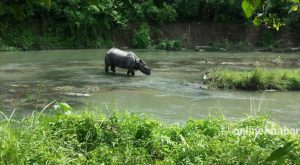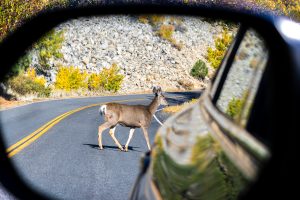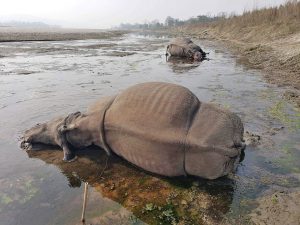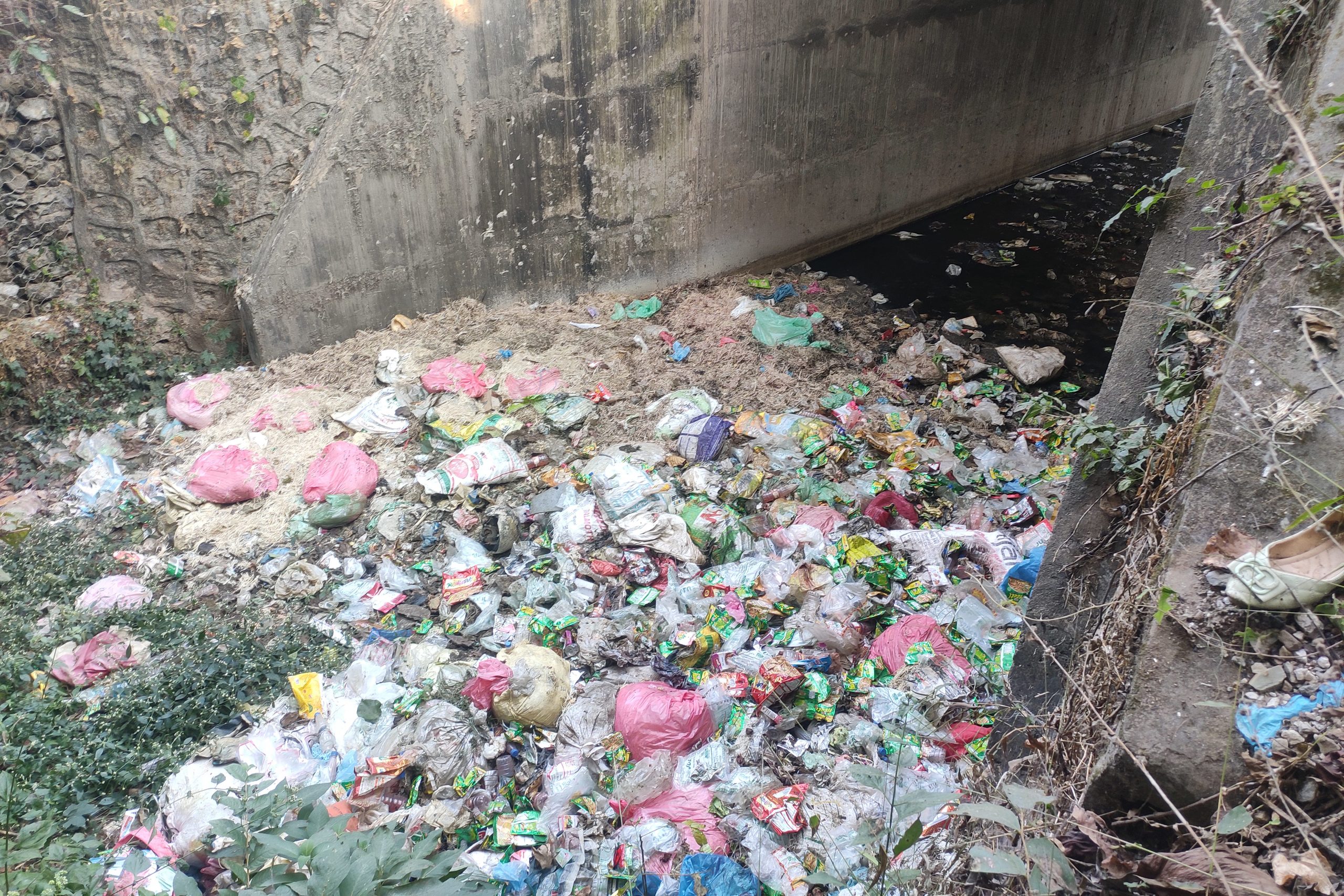
When conservation activist Surajan Shrestha heard that a one-horned rhinoceros, a vulnerable species as per the IUCN Red List, fell into an under-construction roadside ditch and died on January 23, 2022, some kilometres away from the Chitwan National Park in southern Nepal, he immediately wanted to go there to assess the situation. “But, as soon as I saw some of the photographs posted on social media, I withdrew. The scene was so heart-breaking that I was sure I couldn’t see it with my eyes.”
Yet, Shrestha managed his emotions to visit the site after some hours. In the following days, he, along with other stakeholders, pressed authorities to ensure wildlife-friendly infrastructure along the roads cutting through and around protected areas.
The avoidable death of the rhino, the supposed flagship species of the touristic Chitwan National Park and a symbol of the country’s national pride, triggered Nepal’s Department of National Parks and Wildlife Conservation to adopt a wildlife-friendly infrastructure directive in the next three months.
Among various provisions, the directive requires contractors to build underpasses and overpasses for animals to traverse if their construction projects pass through or by protected areas. Officials say the directive has already come into effect and incidents like the one in Chitwan early this year would not be repeated as often.
Months after that, Nepal is actively promoting the directive in international forums such as the 15th meeting of the Conference of Parties of the UN Convention on Biological Diversity (UNCBD), or the biodiversity COP15, currently underway in Montreal, Canada. Wildlife-friendly infrastructure is a rather neglected issue in the overall COP process, but Nepal has given such importance to this topic that not only conservation officials but even officials from the Department of Roads are in Montreal to talk about this.
However, back home, domestic stakeholders are not convinced that the government would be successful in securing wildlife against infrastructural hazards. While longstanding concerns such as a lack of funds and promptness in action are intact, experts and activists also doubt if the authorities might get carried away by external influences.
New rules: New hopes

A 2017 review of the 215 research studies conducted from 2011 to 2015 in different parts of the world concludes the development and presence of roads can reduce landscape permeability, lead to habitat loss, and increase habitat fragmentation, highlighting the need for wildlife-friendly infrastructure. This is true in Nepal’s case also as a large number of wild animals die due to road accidents and other infrastructural hazards here every year. In the fiscal year 2019/20, the Department of National Parks and Wildlife Conservation attributed 108 wildlife deaths to road accidents (18 per cent of the total of 591). This number was 130 in the next year (23 per cent of the total of 573). The latest data for the last fiscal year 2021/22 (mid-July 2021 to mid-July 2022) has not been revealed yet.
There are also frequent cases of protected animals such as elephants and tigers coming out to the roads and either attacking people and property or being hit by vehicles and killed by people.
However, with the new directive coming into effect, the numbers will begin to go down from this fiscal year, claims Maheshwar Dhakal, the chief of the department.
Dhakal says the new rule will secure wildlife-friendly infrastructure along roads, railways, irrigation channels, hydropower dams and embankments, and petroleum pipelines.
In a video message sent to a session at the biodiversity COP15, Dhakal says, “This directive also gives priority to past and ongoing projects as well. It even emphasises regular repair and maintenance of the project for long-term sustainability.”
The Department of Roads is already implementing the new directive during the Kakarbhitta-Laukahi road expansion project. Sushil Babu Dhakal, the chief of the Project Implementation Directorate of the Department of Roads, says the government is doing a critical habitat assessment there before the expansion work so that local wildlife can be saved. Likewise, the department has introduced a biodiversity conservation plan along the 118-km Narayangadh-Butwal road in southern Nepal to redesign existing underpasses and construct some overpasses, according to him.
Dhakal, who is attending the biodiversity COP15 in person, says his department is committed to implementing the directive. “There is no disagreement that we need wildlife-friendly infrastructure. We are committed to safety first in all construction projects.”
Observers have also considered this positive. Dil Raj Khanal, a natural resource researcher attending the biodiversity COP15, says, “If the government is serious about this, this is a welcome step.”
Prey to politics?

At the event on the sidelines of the biodiversity COP15 on Thursday (December 8), Kate Newman, World Wildlife Fund (WWF) vice-president for sustainable infrastructure and people-led initiatives, praised Maheshwar Dhakal’s video message, saying he has been active in building wildlife-friendly infrastructure in Nepal, after which the attendees applauded.
The session, titled Nature-positive Infrastructure, was funded by multilateral agencies such as the Asian Development Bank and big conservation NGOs such as the WWF. The ADB also funded the Department of Roads team’s travel to Montreal; their ID cards during the conference read they are representing the ADB.
And, this is where Khanal sees a serious problem. “Whereas it sounds okay in laymen’s terms, “nature-positive” is politically loaded in the context of biodiversity conservation as [some believe] this promotes the idea that nature should be exploited to generate benefits to humans. Apparently, agencies like the ADB introduced this term to serve their business interests after the concept such as nature-based solutions failed them,” he says, “But, our government officials didn’t understand the gameplay and are running after the phenomenon albeit in the context of wildlife-friendly infrastructure.”
“As nature-based solutions failed the biodiversity conservation concerns, nature-positive solutions will not succeed either,” he says, “Instead, it will enable the private sector to dominate the local communities.”
Instead, Khanal suggests the way forward should have been focused on ecosystem-based approaches that would also incorporate ideas of economic integrity.
Hence, if a nature-positive path is endorsed, some fear that it would pave the way for funding agencies such as the World Bank and the Asian Development Bank to determine the direction of biodiversity conservation projects such as wildlife-friendly infrastructure development in Nepal as they focus on their priorities instead of the locals’ needs, which would be against the spirit of the Convention on Biological Diversity, argues Khanal. It has already been seen in some previous cases that government officials are not brave enough to oppose and correct controversial wording of the projects, sparking disputes among stakeholders in the country.
The promoters also agree that the nature-positive approach allows the private sector to profit from the projects. In response to Onlinekhabar’s question that if funders and the private sector would be privileged by local conservation projects in a “nature-positive” world, WWF International’s Nature-Positive Initiatives Director Gavin Edwards says his organisation wants to “incentivise economic actors” to stop damaging nature and start conserving and restoring it.
He denies the speculations that the target would fail, stressing the importance of a partnership among different stakeholders to ensure its success.
Likewise, ADB Senior Environment Specialist Francesco Ricciardi says also says nature-based solutions and nature-positive investments are supported by strong rationale and best scientific advice, hence they would not fail. “They are transformational tools contributing to ADB’s goals of eradicating extreme poverty and achieving a sustainable, prosperous, inclusive, resilient, and sustainable development in Asia and the Pacific.”*
Nepal’s delegation leader to the biodiversity COP15, Megh Nath Kafle, the chief of the Biodiversity Division in the Ministry of Environment, is also convinced that there could be some hidden interests behind introducing new terms such as nature-positive infrastructure. “Yes, there are debates regarding whether it should be nature-positive or no nature-positive, but we don’t want to involve ourselves in this politics,” Kafle says, “We don’t have any problem with any term per se; if the controversy requires us to take a side, we will choose to stay neutral.”
Kafle’s comment suggests even two departments of the same ministry are at odds over the idea of nature-positive infrastructure. With donor agencies such as the ADB and World Bank funding most road projects in Nepal and with a section of the ministry reluctant to support the idea promoted by them, implementing wildlife-friendly infrastructure directive also looks challenging, according to Khanal.
Old concerns
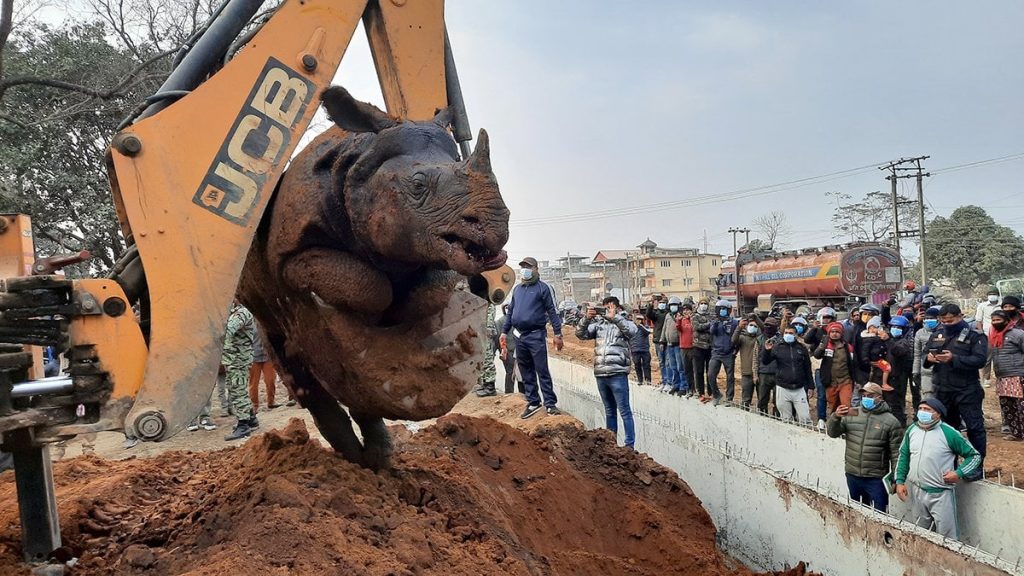
In addition, there are some longstanding concerns that stakeholders back in Nepal are worried about. Many of Nepal’s developmental projects hit roadblocks thanks to a lack of cooperation between different government agencies. Sushil Babu Dhakal, despite expressing his commitment to wildlife-friendly infrastructure, says, “The wildlife conservation department may expect from us sophisticated world-class projects for wildlife-friendly infrastructure, but we at the road department want to complete more projects by utilising a limited amount of resources.”
He also fears focusing too much on wildlife-friendliness might be a challenge in providing donor agencies with a financially justified rationale.
Meanwhile, the Nepal government is infamous for introducing new rules and leaving them unimplemented. The death of the rhinoceros in January is an example as Sushil Babu Dhakal comments, “This incident was not a result of policy deficiency but just an example of a failure to follow safety precautions.”
Then comes the problem of not repairing or maintaining the structures built. Chitwan-based activist Surajan Shrestha says many underpasses along the district’s Narayangadh-Muglin road built in recent years have turned into garbage dumps and are hence unusable for wildlife.
“There is no guarantee that the new underpasses and other tools of wildlife-friendly infrastructure will be managed differently. In that case, there is no reason to be excited about it.”
Time will tell how the government officials respond to his fears.
* The story has been updated to add the ADB’s comment.
This story was produced as a part of the 2022 CBD COP15 Fellowship organised by Internews’ Earth Journalism Network.







